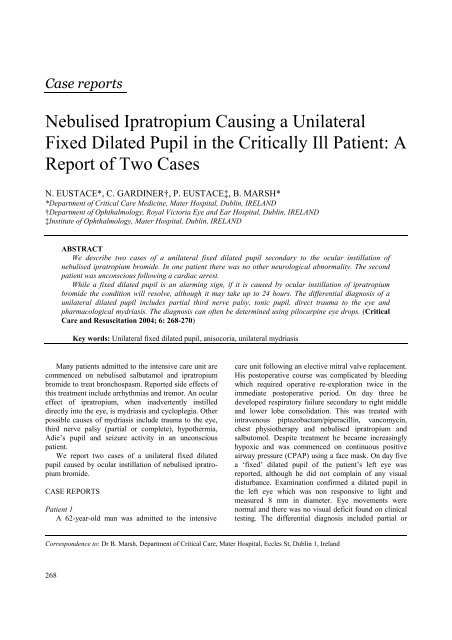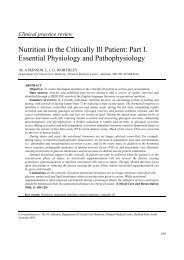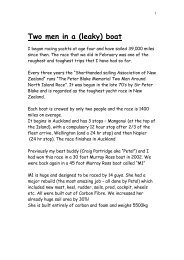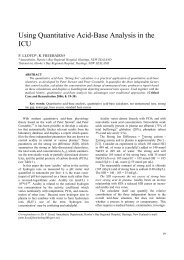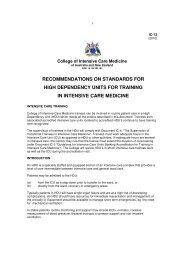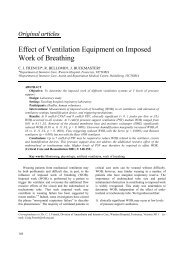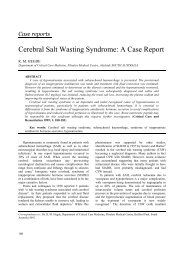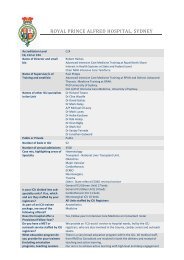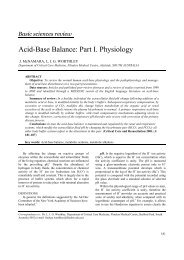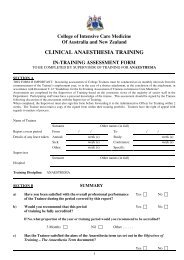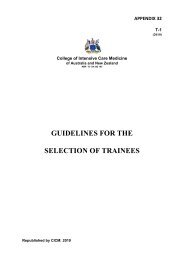Nebulised Ipratropium Causing a Unilateral Fixed Dilated Pupil in ...
Nebulised Ipratropium Causing a Unilateral Fixed Dilated Pupil in ...
Nebulised Ipratropium Causing a Unilateral Fixed Dilated Pupil in ...
You also want an ePaper? Increase the reach of your titles
YUMPU automatically turns print PDFs into web optimized ePapers that Google loves.
Case reports<br />
<strong>Nebulised</strong> <strong>Ipratropium</strong> <strong>Caus<strong>in</strong>g</strong> a <strong>Unilateral</strong><br />
<strong>Fixed</strong> <strong>Dilated</strong> <strong>Pupil</strong> <strong>in</strong> the Critically Ill Patient: A<br />
Report of Two Cases<br />
N. EUSTACE*, C. GARDINER†, P. EUSTACE‡, B. MARSH*<br />
*Department of Critical Care Medic<strong>in</strong>e, Mater Hospital, Dubl<strong>in</strong>, IRELAND<br />
†Department of Ophthalmology, Royal Victoria Eye and Ear Hospital, Dubl<strong>in</strong>, IRELAND<br />
‡Institute of Ophthalmology, Mater Hospital, Dubl<strong>in</strong>, IRELAND<br />
ABSTRACT<br />
We describe two cases of a unilateral fixed dilated pupil secondary to the ocular <strong>in</strong>stillation of<br />
nebulised ipratropium bromide. In one patient there was no other neurological abnormality. The second<br />
patient was unconscious follow<strong>in</strong>g a cardiac arrest.<br />
While a fixed dilated pupil is an alarm<strong>in</strong>g sign, if it is caused by ocular <strong>in</strong>stillation of ipratropium<br />
bromide the condition will resolve, although it may take up to 24 hours. The differential diagnosis of a<br />
unilateral dilated pupil <strong>in</strong>cludes partial third nerve palsy, tonic pupil, direct trauma to the eye and<br />
pharmacological mydriasis. The diagnosis can often be determ<strong>in</strong>ed us<strong>in</strong>g pilocarp<strong>in</strong>e eye drops. (Critical<br />
Care and Resuscitation 2004; 6: 268-270)<br />
Key words: <strong>Unilateral</strong> fixed dilated pupil, anisocoria, unilateral mydriasis<br />
Many patients admitted to the <strong>in</strong>tensive care unit are<br />
commenced on nebulised salbutamol and ipratropium<br />
bromide to treat bronchospasm. Reported side effects of<br />
this treatment <strong>in</strong>clude arrhythmias and tremor. An ocular<br />
effect of ipratropium, when <strong>in</strong>advertently <strong>in</strong>stilled<br />
directly <strong>in</strong>to the eye, is mydriasis and cycloplegia. Other<br />
possible causes of mydriasis <strong>in</strong>clude trauma to the eye,<br />
third nerve palsy (partial or complete), hypothermia,<br />
Adie’s pupil and seizure activity <strong>in</strong> an unconscious<br />
patient.<br />
We report two cases of a unilateral fixed dilated<br />
pupil caused by ocular <strong>in</strong>stillation of nebulised ipratropium<br />
bromide.<br />
CASE REPORTS<br />
Patient 1<br />
A 62-year-old man was admitted to the <strong>in</strong>tensive<br />
care unit follow<strong>in</strong>g an elective mitral valve replacement.<br />
His postoperative course was complicated by bleed<strong>in</strong>g<br />
which required operative re-exploration twice <strong>in</strong> the<br />
immediate postoperative period. On day three he<br />
developed respiratory failure secondary to right middle<br />
and lower lobe consolidation. This was treated with<br />
<strong>in</strong>travenous piptazobactam/piperacill<strong>in</strong>, vancomyc<strong>in</strong>,<br />
chest physiotherapy and nebulised ipratropium and<br />
salbutomol. Despite treatment he became <strong>in</strong>creas<strong>in</strong>gly<br />
hypoxic and was commenced on cont<strong>in</strong>uous positive<br />
airway pressure (CPAP) us<strong>in</strong>g a face mask. On day five<br />
a ‘fixed’ dilated pupil of the patient’s left eye was<br />
reported, although he did not compla<strong>in</strong> of any visual<br />
disturbance. Exam<strong>in</strong>ation confirmed a dilated pupil <strong>in</strong><br />
the left eye which was non responsive to light and<br />
measured 8 mm <strong>in</strong> diameter. Eye movements were<br />
normal and there was no visual deficit found on cl<strong>in</strong>ical<br />
test<strong>in</strong>g. The differential diagnosis <strong>in</strong>cluded partial or<br />
Correspondence to: Dr B. Marsh, Department of Critical Care, Mater Hospital, Eccles St, Dubl<strong>in</strong> 1, Ireland<br />
268
Critical Care and Resuscitation 2004; 6: 268-270 N. EUSTACE, ET AL<br />
complete third nerve palsy, Adie’s pupil or pharmacological<br />
mydriasis. Pilocarp<strong>in</strong>e 0.1% was placed <strong>in</strong> both<br />
eyes; the right and left pupils were unreactive. Thirty<br />
m<strong>in</strong>utes later pilocarp<strong>in</strong>e 1% was given; aga<strong>in</strong> there was<br />
no change <strong>in</strong> the left pupil but the right pupil constricted<br />
confirm<strong>in</strong>g a local pharmacological cause of the fixed<br />
dilated left pupil. The dilated pupil recovered after 24<br />
hours.<br />
Patient 2<br />
A 68 year old man was resuscitated follow<strong>in</strong>g a<br />
cardiac arrest. He was admitted to the <strong>in</strong>tensive care unit<br />
with a Glasgow coma scale score of 3. Three days<br />
follow<strong>in</strong>g his admission he was noted to have an isolated<br />
dilated unreactive pupil. A cerebral computer tomography<br />
(CT) scan was ordered to rule out an <strong>in</strong>tracerebral<br />
lesion. While wait<strong>in</strong>g for the CT scan it was<br />
noted that the pupil dilated follow<strong>in</strong>g a previous dose of<br />
nebulised ipratropium and salbutamol. The CT scan was<br />
unremarkable and the pupil subsequently returned to<br />
normal.<br />
DISCUSSION<br />
Anisocoria (different size pupils) may be due to an<br />
abnormally small pupil (e.g. Horner’s syndrome, where<br />
there is a normal light reaction <strong>in</strong> both eyes) or an<br />
abnormally large pupil (usually associated with an<br />
abnormal light reaction <strong>in</strong> the dilated eye). 1 A fixed<br />
dilated pupil is often considered to be an om<strong>in</strong>ous sign,<br />
particularly <strong>in</strong> a comatose patient, although <strong>in</strong> some<br />
circumstances it may be a benign sign. For example, it<br />
has been described <strong>in</strong> patients receiv<strong>in</strong>g nebulised<br />
ipratropium and salbutamol. 2-4 A case was also reported<br />
<strong>in</strong> a child where the ipratropium bromide was witnessed<br />
splash<strong>in</strong>g <strong>in</strong>to the eye. 5 Hand-to-eye contam<strong>in</strong>ation <strong>in</strong><br />
patients us<strong>in</strong>g scopolam<strong>in</strong>e patches for motion sickness<br />
have also been reported to cause a fixed dilated pupil. 6,7<br />
A dilated pupil can also be caused from a direct ocular<br />
<strong>in</strong>stillation of an alpha adrenergic agent (e.g. ephedr<strong>in</strong>e, 8<br />
phenylephr<strong>in</strong>e, 9 coca<strong>in</strong>e 10 ).<br />
<strong>Ipratropium</strong> bromide is a useful bronchodilator<br />
which is often used <strong>in</strong> comb<strong>in</strong>ation with salbutamol <strong>in</strong><br />
<strong>in</strong>tensive care patients. 11 It is an antimuscar<strong>in</strong>ic agent<br />
and, like atrop<strong>in</strong>e, causes mydriasis, an effect noted<br />
s<strong>in</strong>ce the middle ages from ocular adm<strong>in</strong>istration of<br />
extracts from the plant Atropa belladonna. Its effect on<br />
the eye may last up to 24 hours.<br />
Pilocarp<strong>in</strong>e is a direct act<strong>in</strong>g parasympathomimetic<br />
agent which duplicates the actions of acetylchol<strong>in</strong>e<br />
caus<strong>in</strong>g constriction of the pupil by stimulat<strong>in</strong>g the<br />
sph<strong>in</strong>cter pupillae and alter<strong>in</strong>g accommodation by<br />
contract<strong>in</strong>g the ciliary muscles. It also reduces <strong>in</strong>tra<br />
ocular pressure. Its duration of action is 4 to 6 hours.<br />
Instillation of pilocarp<strong>in</strong>e drops can also be used to<br />
localise the cause of a fixed dilated pupil, the<br />
differential diagnosis of which <strong>in</strong>cludes,<br />
a. Trauma to the eye, which is associated with small<br />
radial splits <strong>in</strong> the iris (the red reflex us<strong>in</strong>g plus 10<br />
on the ophthalmoscope highlights these tears and<br />
there are usually other signs of contusion to the eye<br />
and orbit)<br />
b. Adie’s pupil or any other causes of a tonic pupil,<br />
which <strong>in</strong>cludes autonomic neuropathies from other<br />
causes<br />
c. Partial or complete third nerve palsy<br />
d. Pharmacological mydriasis after <strong>in</strong>stillation of<br />
mydriatic agents <strong>in</strong>advertently or <strong>in</strong>tentionally to<br />
exam<strong>in</strong>e the fundus or treat a perforat<strong>in</strong>g eye <strong>in</strong>jury<br />
and,<br />
e. A prosthetic eye.<br />
A tonic pupil occurs follow<strong>in</strong>g damage or disease of<br />
the ciliary ganglion which causes post ganglionic<br />
denervation hypersensitivity. This is demonstrated by<br />
pupillary constriction to dilute pilocarp<strong>in</strong>e (Figure 1).<br />
Figure 1. A flow diagram us<strong>in</strong>g topical pilocarp<strong>in</strong>e to confirm the<br />
aetiology of a fixed dilated pupil.<br />
S<strong>in</strong>ce pilocarp<strong>in</strong>e is water soluble it is a simple<br />
matter to dilute 1% pilocarp<strong>in</strong>e to a 1/10 solution. While<br />
a tonic pupil constricts to a 1/10 solution of pilocarp<strong>in</strong>e,<br />
a normal pupil rema<strong>in</strong>s unaffected. However, if 1%<br />
pilocarp<strong>in</strong>e is <strong>in</strong>stilled, this will constrict a normal pupil<br />
or a dilated pupil secondary to a third nerve palsy. If<br />
there is no constriction to undiluted pilocarp<strong>in</strong>e 1% the<br />
diagnosis is consistent with ocular <strong>in</strong>stillation of a<br />
mydriatic agent such as ipratropium bromide, 12 as it<br />
blocks the response of the sph<strong>in</strong>cter muscle to<br />
chol<strong>in</strong>ergic stimulation. 13<br />
269
N. EUSTACE, ET AL Critical Care and Resuscitation 2004; 6: 268-270<br />
The Adie pupil may present as a dilated pupil that<br />
only slowly reacts to light. The aetiology of this<br />
condition is unknown. Initially, it is unilateral <strong>in</strong> 80% of<br />
patients. As outl<strong>in</strong>ed earlier the pupil will constrict <strong>in</strong><br />
response to pilocarp<strong>in</strong>e 0.1% eye drops. 12<br />
Complications of pharmacological mydriasis <strong>in</strong>clude<br />
blurred vision and acute angle closure glaucoma. 14 A<br />
conscious patient with acute angle closure glaucoma will<br />
usually compla<strong>in</strong> of pa<strong>in</strong> and visual loss. This<br />
complication is difficult to detect <strong>in</strong> the unconscious<br />
patient and there are reports of permanent visual loss<br />
result<strong>in</strong>g from <strong>in</strong>advertent ocular <strong>in</strong>stillation of ipratro-<br />
pium bromide. 14,15<br />
In summary, <strong>in</strong>stillation of ipratropium bromide<br />
should be considered as a possible cause of a unilateral<br />
fixed dilated pupil. Pilocarp<strong>in</strong>e 1/10 solution will<br />
constrict the dilated Adie pupil. A third nerve palsy will<br />
constrict with Pilocarp<strong>in</strong>e 1% drops, while a local<br />
pharmacological cause will be unresponsive.<br />
Received 2 June 04<br />
Accepted 1 July 04<br />
REFERENCES<br />
1. Czarnecki JS, Pilley SF, Thompson HS.The analysis of<br />
anisocoria. The use of photography <strong>in</strong> the cl<strong>in</strong>ical<br />
evaluation of unequal pupils. Can J Ophthalmol<br />
1979;14:297-302.<br />
2. Helpr<strong>in</strong> GA, Clarke GM. <strong>Unilateral</strong> fixed dilated pupil<br />
associated with nebulised ipratropium bromide. Lancet<br />
1986;2:1469.<br />
270<br />
3. Geraerts SD, Plotz FB, van Goor C, Duval EL, van<br />
Vught H. <strong>Unilateral</strong> fixed dilated pupil <strong>in</strong> a ventilated<br />
child with asthma. Eur J Emerg Med 2000;7:247-248.<br />
4. Goldstien JB, Biousse V, Newman NJ. <strong>Unilateral</strong><br />
pharmacological mydriasis <strong>in</strong> a patient with respiratory<br />
compromise. Arch Ophthalmol 1997;115:806.<br />
5. Ryan CA. <strong>Ipratropium</strong> bromide <strong>in</strong>duced unilateral<br />
mydriasis. Ir Med J 1997;90:76.<br />
6 Verdier DD, Kennerdell JS. <strong>Fixed</strong> dilated pupil<br />
result<strong>in</strong>gfrom transdermal scopolam<strong>in</strong>e. Am J Opthalmol<br />
1982; 93:803-804.<br />
7 Price BH. Anisocoria from scopolam<strong>in</strong>e patches. JAMA<br />
1985;253: 1561.<br />
8. Prielipp RC. <strong>Unilateral</strong> mydriasis after <strong>in</strong>duction of<br />
anaesthesia. Can J Anaesth 1994;41:140-143.<br />
9. Rub<strong>in</strong> MM, Sadoff RS, Cozzi GM.Postoperative<br />
unilateral mydriasis due to phenylephr<strong>in</strong>e: a case report.<br />
J Oral Maxillofac Surg 1990;48:621-623.<br />
10. Zeiter JH, McHenry JG, McDermott ML.<strong>Unilateral</strong><br />
pharmacologic mydriasis secondary to crack coca<strong>in</strong>e.<br />
Am J Emerg Med 1990;8:568-569.<br />
11. O’Doherty MJ, Thomas SHL. Nebuliser therapy <strong>in</strong> the<br />
<strong>in</strong>tensive care unit. Thorax 1997;52(Suppl 2):S56–S59.<br />
12. Rosen ES, Eustace P, Thompson HS, Cumm<strong>in</strong>g WJK.<br />
Editors. Neuro-ophthalmology. Mosby 1998:13:16.<br />
13. Bartlett J, Fiscella R, Ghormley N, Jaanus S, Rowsey J,<br />
Zimmerman T. Editors. Ophthalmic drug Facts. Wolters<br />
Kluwer 1999.49.<br />
14. Packe GE, Cayton RM, Mahoudi N. <strong>Nebulised</strong><br />
ipratropium bromide and salbutamol caus<strong>in</strong>g closedangle<br />
glaucoma. Lancet 1994;22:691.<br />
15. Shah P, dhurjon L, Metcalfe T, Gibson JM. Acute angle<br />
closure glaucoma associated with nebulised ipratropium<br />
bromide and salbutamol. BMJ 1992:304:40-41.


